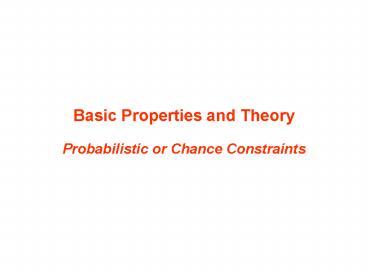Basic Properties and Theory - PowerPoint PPT Presentation
1 / 14
Title:
Basic Properties and Theory
Description:
Low partial moment constraint (considered in finance literature from 70-th) ... Various variants of low partial moment were successfully applied in stochastic ... – PowerPoint PPT presentation
Number of Views:33
Avg rating:3.0/5.0
Title: Basic Properties and Theory
1
Basic Properties and Theory
- Probabilistic or Chance Constraints
2
Percentile v.s. Probabilistic constraints
- Proposition 1.
- Let f (x,y) be a loss functions and ?a(x) be
a-percentile (a-VaR) then - ?a(x) ? ? ? Pr f
(x,y) ? ? ? a - Proof follows from the definition of
a-percentile ?a(x) - ?a(x) min ? Pr f (x,y) ? ? ?
a - Generally, ?a(x) is nonconvex (e.g., discrete
distributions), therefore ?a(x) ? ? as well as
Pr f (x,y) ? ? ? a may be nonconvex
constraints - Probabilistic constraints were considered by
Prekopa, Raik, Szantai, Kibzun, Uryasev, Lepp,
Mayer, Ermoliev, Kall, Pflug, Gaivoronski,
3
Non-Percentile Risk Measures
- Low partial moment constraint (considered in
finance literature from 70-th) - E((f (x,y) - ? ))a ? b , a ?
0, g max 0, g - special cases
- a 0 gt Pr f (x,y) - ? ? 0
- a 1 gt E (f (x,y) - ?)
- a 2 , ? E f (x,y) gt
semi-variance E((f (x,y) - ?))2 - Regret (King, Dembo) is a variant of low partial
moment with - ? 0 and f (x,y)
performance - benchmark - Various variants of low partial moment were
successfully applied in stochastic optimization
by Ziemba, Mulvey, Zenios, Konno, King, Dembo,
Mausser, Rosen, - Haneveld and Prekopa considered a special case of
low partial moment with a 1, ? 0 integrated
chance constraints
4
Percentile v.s. Low Partial Moment
- Low partial moment with a gt 0 does not control
percentiles. It is applied when loss can be
hedged at additional cost - total expected value expected cost
without high losses -
expected cost of high losses - expected cost of high losses p
E(f (x,y) - ?) - Percentiles constraints control risks explicitly
in percentile terms. - Testury and Uryasev1 established equivalence
between CVaR approach (percentile measure) and
low partial moment, a 1 (non-percentile
measure) in the following sense - a) Suppose that a decision is optimal in an
optimization problem with a CVaR constraint, then
the same decision is optimal with a low partial
moment constraint with some ? gt 0 - b) Suppose that a decision is optimal in an
optimization problem with a low partial moment
constraint, then the same decision is optimal
with a CVaR constraint at some confidence level
a. - 1Testuri, C.E. and S. Uryasev. On Relation
between Expected Regret and Conditional
Value-At-Risk. Research Report 2000-9. ISE Dept.,
University of Florida, August 2000. Submitted to
Decisions in Economics and Finance journal.
(www.ise.ufl.edu/uryasev/Testuri.pdf)
5
Probabilistic or Chance Constraints
Probability or chance constraints with linear
functions
Definition
Deterministic equivalent program (DEP) if each
i corresponds to a distinct linear constraint,
Ai is a fixed row vector, and Fi is
distribution of hi, then
6
An Example with Disconnected Sets
Suppose
x ? ? ,
Indeed, for the first atom we have
Similar, we can obtain inequalities for the
second atom.
7
Quasi and Logarithmically Concave Measures
A probability measure is quasi-concave if for
any convex measurable sets U and V and any 0 ?
? ? 1
Definition
A probability measure is Log-concave if for any
convex measurable sets U and V and any 0 ? ? ?
1
Definition
Statement Log-concave ? quasi-concave
8
Convexity And Closeness of the Set
Suppose A is fixed and h has an associated
quasi-concave probability measure P. Then K1
(?) is a closed convex set for 0 ? ? ? 1.
Theorem 14
Proof
Convexity let
, suppose
Closure suppose
. If for some
subsequence of ,
then , and, consequently,
9
Quasi-Concave Measures
If f is the density of a continuous probability
distribution in ?m and is convex
on ?m, then the probability measure defined
for all Borel sets B in ?m is quasi-concave.
Theorem 15
10
Convexity of Feasibility Set
Suppose A is fixed and the components hi , i
1, , m1, of h are stochastically independent
random variables with logarithmically concave
probability measures, Pi , and distribution
functions, Fi , then K1 (?) is convex, and
Theorem 16
Proof from independence
Convexity
the logarithm of Fi (Ai? x) is a concave
function, and, hence, K1 (?) is convex.
11
Convexity of Feasibility Set (cont'd)
If A1? , , An1? , h have a joint normal
distribution with a common covariance structure,
a matrix C, such that where rij, si are
constants for all i and j, then K1 (?) is
convex for ? ? .
Theorem 17
12
Deterministic Equivalents
Suppose that m1 1, h1 0, and A1? has
mean and covariance matrix C1 , then
where ? is the standard normal distribution
function.
Theorem 18
Proof
Substitution in the definition of K1 (?) yields
the result.
13
Deterministic Equivalents (cont'd)
If Pi is the probability measure of hi and
Fi is the distribution function for hi then
using substitution , the
problem with probabilistic constraints
(1)
is reduced to the deterministic equivalent
problem
(2)
14
Deterministic Equivalents (cont'd)
Suppose x and ?, ? are optimal and
optimal dual solutions of (2), respectively,
where cTx bT ? h T?. Define
Equivalent stochastic program with simple
recourse to (1) is
(3)
The following theorem gives conditions for
one-side equivalence of (1) and (3)
For the defined as a function of some
optimal ? for the dual to (1), if x is
optimal in (1), there exists y ? 0 almost
surely such that ( x, y) is optimal in (3).
Theorem 19































